.

2.07.2015
New Horizons Color Images Reveal Two Distinct Faces of Pluto, Series of Spots that Fascinate
New color images from NASA’s New Horizons spacecraft show two very different faces of the mysterious dwarf planet, one with a series of intriguing spots along the equator that are evenly spaced. Each of the spots is about 300 miles in diameter, with a surface area that’s roughly the size of the state of Missouri.
Scientists have yet to see anything quite like the dark spots; their presence has piqued the interest of the New Horizons science team, due to the remarkable consistency in their spacing and size. While the origin of the spots is a mystery for now, the answer may be revealed as the spacecraft continues its approach to the mysterious dwarf planet. “It’s a real puzzle—we don’t know what the spots are, and we can’t wait to find out,” said New Horizons principal investigator Alan Stern of the Southwest Research Institute, Boulder. “Also puzzling is the longstanding and dramatic difference in the colors and appearance of Pluto compared to its darker and grayer moon Charon.”
New Horizons team members combined black-and-white images of Pluto and Charon from the spacecraft’s Long-Range Reconnaissance Imager (LORRI) with lower-resolution color data from the Ralph instrument to produce these views. We see the planet and its largest moon in approximately true color, that is, the way they would appear if you were riding on the New Horizons spacecraft. About half of Pluto is imaged, which means features shown near the bottom of the dwarf planet are at approximately at the equatorial line.
.

.
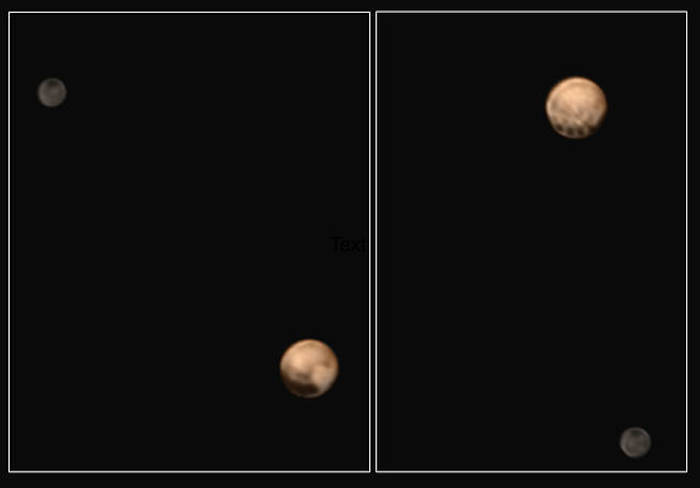
New color images from NASA’s New Horizons spacecraft show two very different faces of the mysterious dwarf planet, one with a series of intriguing spots along the equator that are evenly spaced.
.
Instruments Prepare to Search for Clouds in Pluto’s Atmosphere
If Pluto has clouds, New Horizons can detect them. Both the high-resolution LORRI imager and the Ralph color imager will be used to look for clouds across the face of Pluto during its approach and departure from the planet. “We’re looking for clouds in our images using a number of techniques,” said science team postdoc Kelsi Singer of the Southwest Research Institute, “If we find clouds, their presence will allow us to track the speeds and directions of Pluto’s winds.”
.
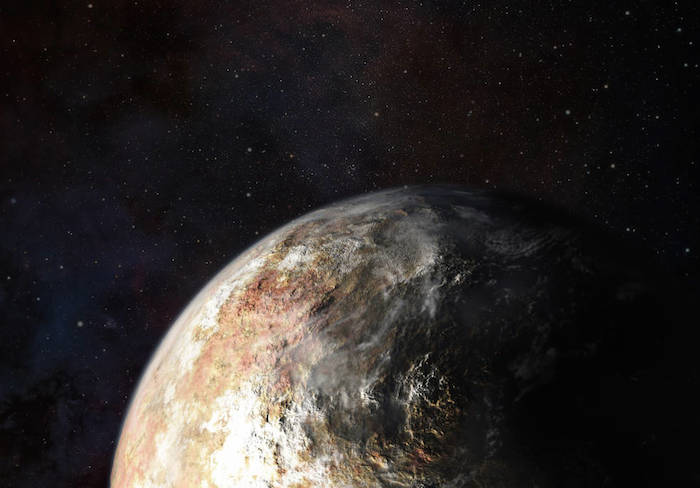
An artist’s conception of clouds in Pluto’s atmosphere.
Credits: JHUAPL
.
New Horizons Team Says “Bravo!” To Earth-Based Pluto Observers
For more than two decades, planetary scientists have raced to get a spacecraft to Pluto against predictions that its atmosphere would disappear—literally freezing onto the surface—before it could be explored. This week, planetary scientists using ground-based telescopes and NASA’s SOFIA airborne observatory confirmed that “Pluto’s atmosphere is alive and well, and has not frozen out on the surface,” according to New Horizons deputy project scientist Leslie Young, Southwest Research Institute, Boulder. Added Young, “We’re delighted!”
“The SOFIA observations will also be essential for linking ground-based studies to the results from the New Horizons Pluto encounter for decades to come”, said Cathy Olkin, Southwest Research Institute, Boulder, co-investigator on NASA’s New Horizons mission.
.
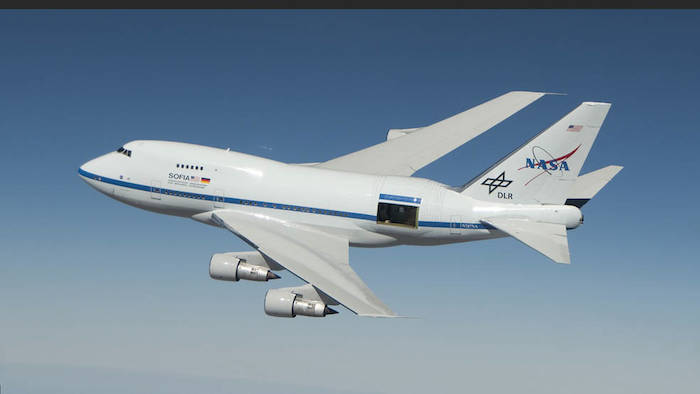
Credits: NASA-Jim Ross
.
PEPSSI Instrument Tastes Pluto’s Atmosphere
The Pluto Energetic Particle Spectrometer Science Investigation (PEPSSI) instrument aboard New Horizons is sending back data daily, sampling the space environment near Pluto. PEPSSI is designed to detect ions (atoms that have lost or gained one or more electrons) that have escaped from Pluto’s atmosphere. As they depart, these atoms become caught up in the solar wind, the stream of subatomic particles that emanates from the Sun. PEPSSI’s job is to tell scientists about the composition of Pluto’s escaping atmosphere and how quickly the atmosphere is escaping.
.
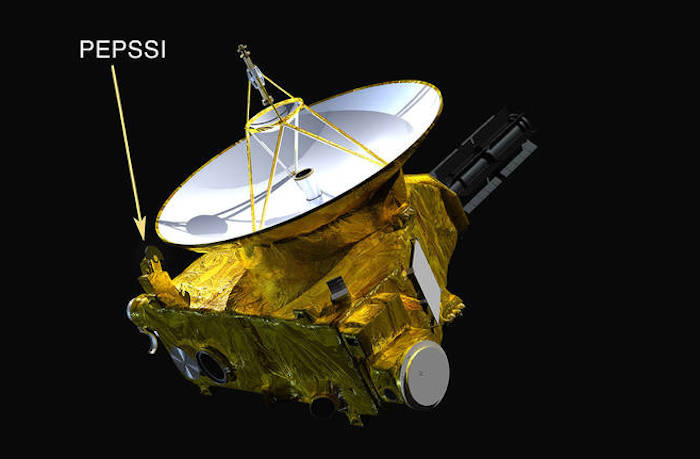
The location of New Horizons’ Pluto Energetic Particle Spectrometer Science Investigation (PEPSSI) instrument is shown.
New Horizons is now less than 9.5 million miles (15 million kilometers) from the Pluto system. The spacecraft is healthy and all systems are operating normally.
The Johns Hopkins University Applied Physics Laboratory in Laurel, Maryland, designed, built, and operates the New Horizons spacecraft, and manages the mission for NASA’s Science Mission Directorate. The Southwest Research Institute, based in San Antonio, leads the science team, payload operations and encounter science planning. New Horizons is part of the New Frontiers Program managed by NASA’s Marshall Space Flight Center in Huntsville, Alabama.
Quelle: NASA
...
Clyde Tombaugh Asche auf der Reise zu Pluto
.
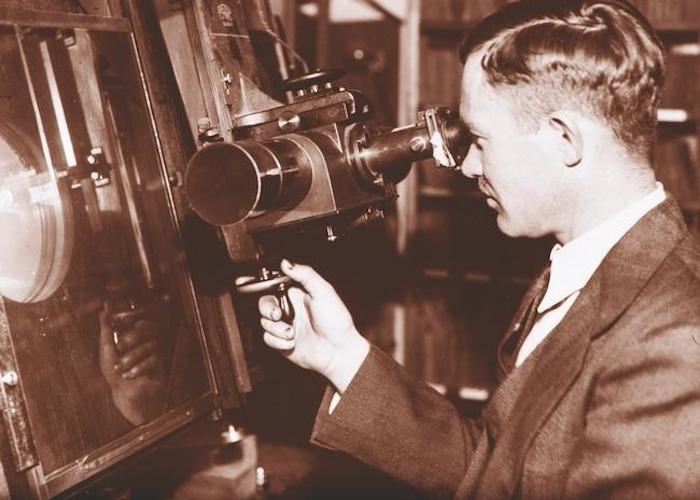
Clyde Tombaugh machte erstes Bild von Pluto am Lowell Observatory in Flagstaff, Arizona, 1930. Kredit Kansas Historical Society, Topeka.
.
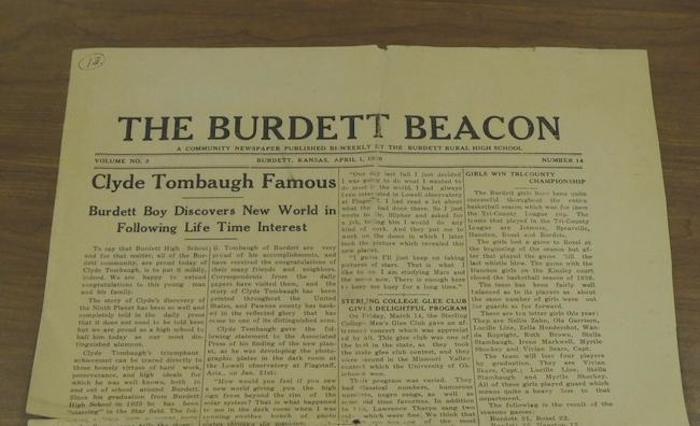
The Burdett Beacon from 1930 annoucing Clyde Tombaugh's accomplishment.
.
Just 12 days away from Pluto, the New Horizons spacecraft will pass by with more than just scientific equipment onboard.
Launched in 2006, the spacecraft carries a small amount of Clyde Tombaugh's ashes. Tombaugh, who grew up in Burdett, discovered Pluto in 1930.
"He was born in Illinois in 1906," Dave Webb, historian with the Kansas Heritage Center, said. "His family moved to a farm near Burdett after World War I."
According to the Kansas Historical Society, as a youngster, Tombaugh's father and uncle encouraged his interest in astronomy. Tombaugh was a self-taught amateur astronomer who made his own telescopes from hand-ground mirrors and parts of farm equipment. He graduated from Burdett High School in 1925.
In 1928 Tombaugh made a 9 inch telescope that enabled him to make very accurate and detailed sketches of Jupiter and Mars. Seeking advice from professional astronomers, he sent his sketches to the Lowell Observatory in Flagstaff, Arizona.
The Lowell staff was looking for an amateur astronomer capable of operating their new photographic telescope, according to KHS. They were sufficiently impressed with his work to offer Tombaugh the position on a trial basis. In early January 1929, he boarded a train for Flagstaff.
"After spending 28 hours in a chair car on the Santa Fe," he wrote, "I arrived at Flagstaff in the early afternoon of 15 January, 1929. Dr. Slipher met me at the depot and drove me up Mars Hill. The yellow pine forest was in stark contrast to the treeless plains of Western Kansas. I was rather unnerved by it all, everybody were strangers, 1,000 miles from home, and not enough money in my wallet for a return ticket home"
According to KHS, late in the afternoon on February 18, 1930, the 24-year-old Tombaugh was gazing into the eyepiece of a Zeiss Blink microscope at photographic images of a star field, examining a pair of plates taken in mid-January. His attention was caught by one of the millions of minute specks of lights whose image had moved slightly between one photograph and the next. He checked and rechecked his photographs for 45 minutes before calling his supervisors.
The observatory staff watched the star for a few weeks to confirm the movement, and on March 13, 1930, the discovery of the ninth planet was officially announced.
"It was headline news all over the world," Webb said. "We have the original newspaper from Burdett that announced the discovery. He was quite the celebrity."
Tombaugh received an offer of a scholarship for the University of Kansas University, which he accepted.
"He earned his degree from KU in 1936," Webb said. "He earned his masters from KU in 1939. He concluded his career as an astronomy professor at New Mexico State University. Besides Pluto, he discovered clusters of galaxies, a super cluster, six star clusters, two comets and 775 asteroids."
Webb said Dodge City historian Ida Ellen Rath exchanged several letters with the astronomer and wrote children's books on him.
"We have the letters and clippings she kept," he said. "We included him in 999 Kansas Characters: Ad Astra because of his significance to Kansas."
Though Tombaugh died before Pluto was downgraded to a dwarf planet, his wife discussed her thoughts on the matter.
"She was disappointed, but said she felt her husband would have appreciated the attention that it brought to astronomy," he said. "The state legislatures in New Mexico and Illinois passed resolutions that when Pluto was visible in the sky over their states, it was a planet."
Tombaugh's remains will fly past Pluto with New Horizons on July 14 and then on past Kuiper Belt objects in the succeeding years, according to NASA's website. As such, his ashes have become the first to be launched to the stars.
New Horizons, the first mission to Pluto, will provide the closest look ever at the dwarf planet while completing the initial reconnaissance of the solar system. The mission is the first in NASA's New Frontiers Program. The Johns Hopkins University Applied Physics Laboratory in Laurel, Maryland, manages the mission for NASA's Science Mission Directorate and designed, built and operates the New Horizons spacecraft.
Quelle: DODGE CITY DAILY GLOBE
.
Update: 3.07.2015
.
Pluto: The 'Other' Red Planet
What color is Pluto? The answer, revealed in the first maps made from New Horizons data, turns out to be shades of reddish brown. Although this is reminiscent of Mars, the cause is almost certainly very different. On Mars the coloring agent is iron oxide, commonly known as rust. On the dwarf planet Pluto, the reddish color is likely caused by hydrocarbon molecules that are formed when cosmic rays and solar ultraviolet light interact with methane in Pluto’s atmosphere and on its surface.
“Pluto’s reddish color has been known for decades, but New Horizons is now allowing us to correlate the color of different places on the surface with their geology and soon, with their compositions,” said New Horizons principal investigator Alan Stern of the Southwest Research Institute, Boulder, Colorado. “This will make it possible to build sophisticated computer models to understand how Pluto has evolved to its current appearance."
Experts have long thought that reddish substances are generated as a particular color of ultraviolet light from the sun, called Lyman-alpha, strikes molecules of the gas methane (CH4) in Pluto’s atmosphere, powering chemical reactions that create complex compounds called tholins. The tholins drop to the ground to form a reddish “gunk.” Recent measurements with New Horizons’ Alice instrument reveal that a diffuse Lyman-alpha glow falling on Pluto from all directions in interplanetary space is strong enough to produce almost as much tholin as the direct rays of the sun. “This means Pluto’s reddening process occurs even on the night side where there’s no sunlight, and in the depths of winter when the sun remains below the horizon for decades at a time,” said New Horizons co-investigator Michael Summers, George Mason University, Fairfax, Virginia.
Tholins have been found on other bodies in the outer solar system, including Titan and Triton, the largest moons of Saturn and Neptune, respectively, and made in laboratory experiments that simulate the atmospheres of those bodies.
The mission’s first map of Pluto is in approximate true color—that is, the color you would see if you were riding on New Horizons. At left, a map of Pluto’s northern hemisphere composed using high-resolution black-and-white images from New Horizons LORRI instrument. At right is a map of Pluto’s colors created using data from the Ralph instrument. In the center is the combined map, produced by merging the LORRI and Ralph data.
“Now the unique colors and characteristics of its varied terrains are coming into view," said Simon Porter, a member of the New Horizons Geology and Geophysics team. Added Alex Parker, a member of the New Horizons Composition team, "Pluto's largest dark spot is clearly more red than the majority of the surface, while the brightest area appears closer to neutral gray."
Scientists hope to learn more about the cause of Pluto’s reddish tint as New Horizons closes in for its July 14 flyby.
.
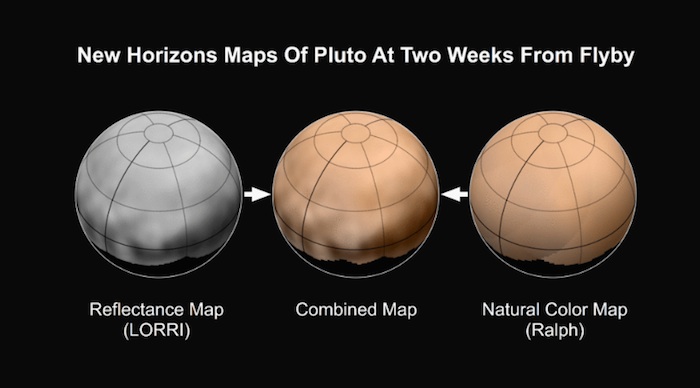
.
Pluto: A Remarkable World
Even though New Horizons is still millions of miles from Pluto, its highest resolution imager is revealing a remarkably complex surface.
This image of Pluto and its largest moon Charon, taken by the LORRI instrument on July 1, 2015 from a distance of 10 million miles (16 million kilometers), shows features as small as 100 miles (160 kilometers) across.
This view shows the side of Pluto that will be viewed in highest resolution by New Horizons when it flies past the planet on July 14. Near the equator, sharp edged dark regions are surrounded by brighter terrain. Farther north, shadings are more subtle, with suggestions of a more varied, mottled surface.
“Even at this resolution, Pluto looks like no other world in our solar system,” said mission scientist Marc Buie of the Southwest Research Institute, Boulder. “We’re already seeing a remarkable amount of detail, and the complexity continues to increase as the images get better.”
.
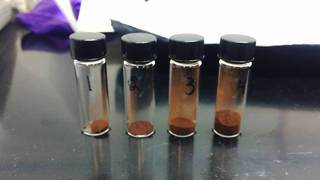
Scientists at Johns Hopkins University’s Hörst Laboratory have produced complex chemical compounds called tholins, which may give Pluto its reddish hue.
Credits: Chao He, Xinting Yu, Sydney Riemer, and Sarah Hörst, Johns Hopkins University
.
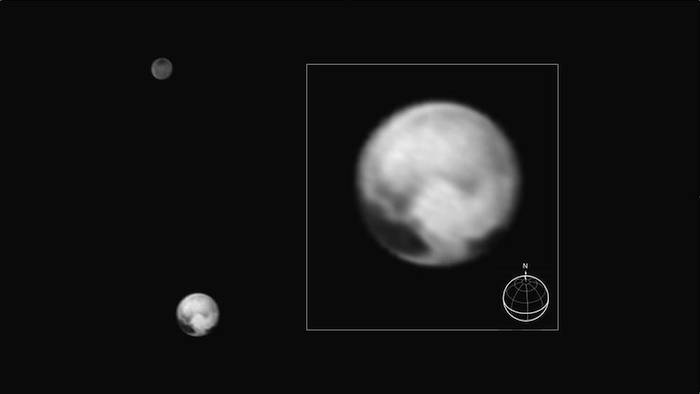
Pluto and its largest moon Charon seen from New Horizons on July 1, 2015. The inset shows Pluto enlarged; features as small as 100 miles (160 kilometers) across are visible.
Credits: NASA/JHUAPL/SWRI
Quelle: NASA
-
Update: 4.07.2015
.
What we will and will not see during the Pluto fly-by
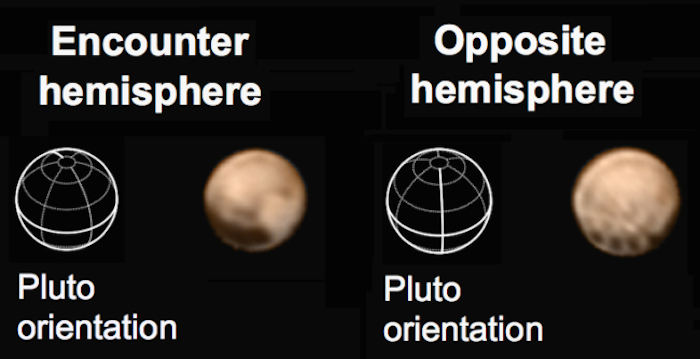
The images above, released today by the New Horizons’ science team, provide the best global view so far of Pluto’s two hemispheres. I have cropped and rearranged the original to focus on Pluto.
The images illustrate some basic new knowledge about the planet. For one, scientists have now identified the planet’s poles, based upon its rotation. While scientists had had a very rough vague idea of Pluto’s rotation and inclination beforehand, they have now pinned it down pretty precisely.
The images also show the planet’s most striking and unique features, though not with enough resolution to tell us what they are.
New color images from NASA’s New Horizons spacecraft show two very different faces of the mysterious dwarf planet, one with a series of intriguing spots along the equator that are evenly spaced. Each of the spots is about 300 miles in diameter, with a surface area that’s roughly the size of the state of Missouri.
Scientists have yet to see anything quite like the dark spots; their presence has piqued the interest of the New Horizons science team, due to the remarkable consistency in their spacing and size. While the origin of the spots is a mystery for now, the answer may be revealed as the spacecraft continues its approach to the mysterious dwarf planet. “It’s a real puzzle—we don’t know what the spots are, and we can’t wait to find out,” said New Horizons principal investigator Alan Stern of the Southwest Research Institute, Boulder. “Also puzzling is the longstanding and dramatic difference in the colors and appearance of Pluto compared to its darker and grayer moon Charon.”
This image release also shows us what we will and will not see during the fly-by. The image on the left is the “encounter hemisphere.” This is the hemisphere that will be in view during New Horizons’ July 14 fly-by. We shall get very nice high resolutions of much of this hemisphere.
The other hemisphere, however, will not be facing us during the fly-by. Unless that can get some high resolution images before it rotates out of view, the row of large dark spots at the equator will remain a mystery.
The images also suggest that, because of Pluto’s tilt, much of the southern hemisphere is not going to be seen at all. It will remain an additional mystery for the many decades that are going to pass before another spacecraft finally returns to this distant place.
Quelle: BTB
---
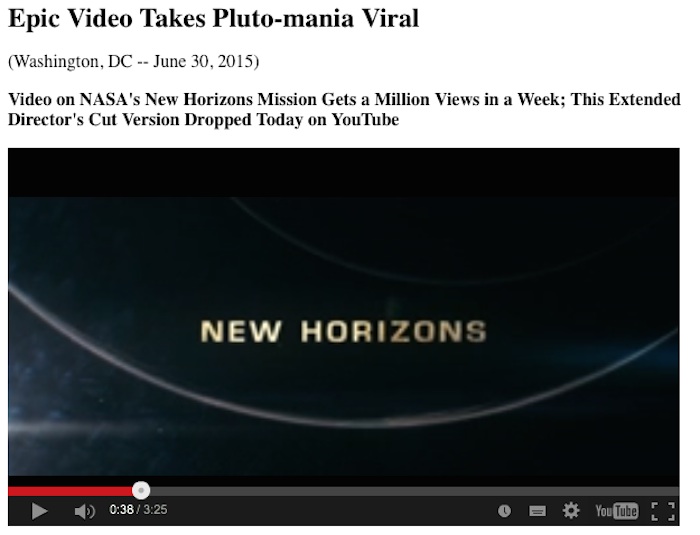
Video-Link: https://www.youtube.com/watch?v=-Hbp8QYUQpc#t=39
This extended version of a viral video detailing NASA's New Horizons mission to Pluto, entitled "New Horizons [Extended Version]" was released today to the public via YouTube. A shorter version of the video had gone viral just two weeks prior, amassing over a million views in less than a week.
The video, commissioned by the non-profit National Space Society, highlights the historical significance of the New Horizons mission.
The fastest spacecraft ever created, New Horizons will speed past Pluto on July 14, 2015, 50 years to the day after humans first explored Mars with NASA's Mariner 4 on July 14, 1965. The spacecraft will beam back high resolution imagery and invaluable scientific data of the dwarf planet's surface for the first time in human history, thus bringing a dramatic culmination to 50 years of NASA's initial efforts in planetary reconnaissance.
"This extended version of the video, New Horizons, is amazing, showing why we explore the planets, and what an incredible and historic accomplishment human beings have achieved in the past 50 years - from the first missions to Venus and Mars to New Horizons at Pluto - in that pursuit," said Alan Stern, NSS member and Principal Investigator of the New Horizons mission.
About the National Space Society (NSS): NSS is an independent nonprofit educational membership organization dedicated to the creation of a spacefaring civilization. NSS is widely acknowledged as the preeminent citizen's voice on space, with over 50 chapters in the United States and around the world. The Society publishes Ad Astra magazine, an award-winning periodical chronicling the most important developments in space
Quelle: NSS
5013 Views
